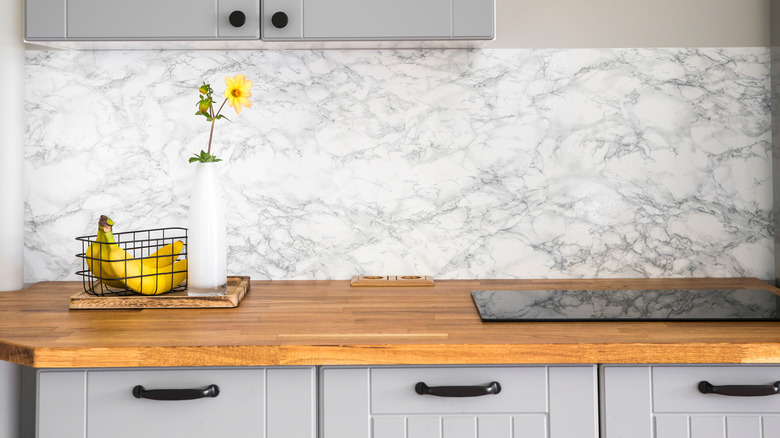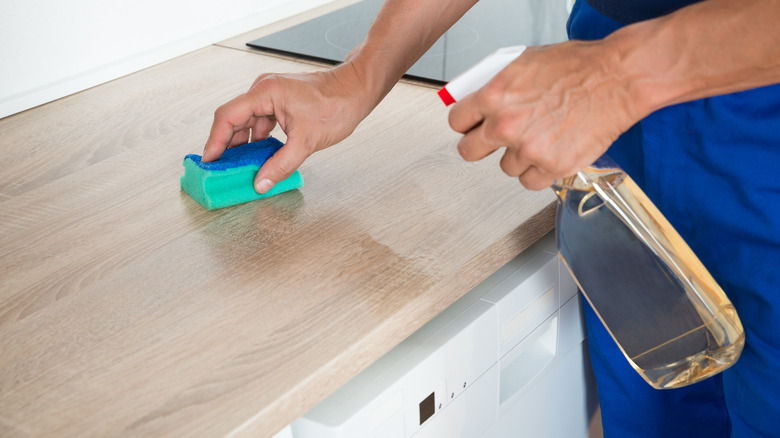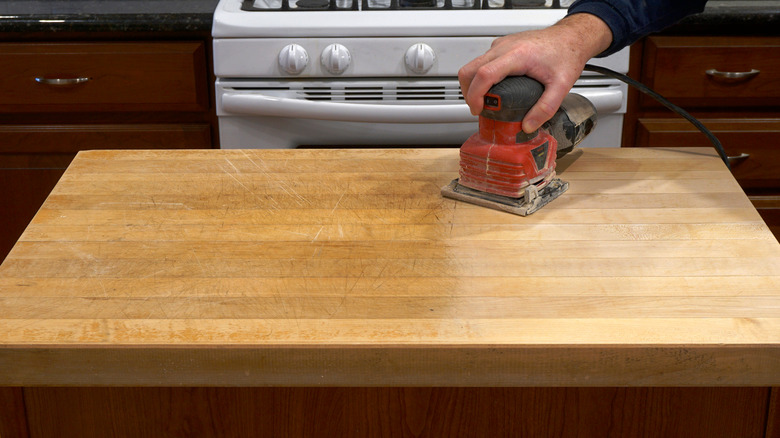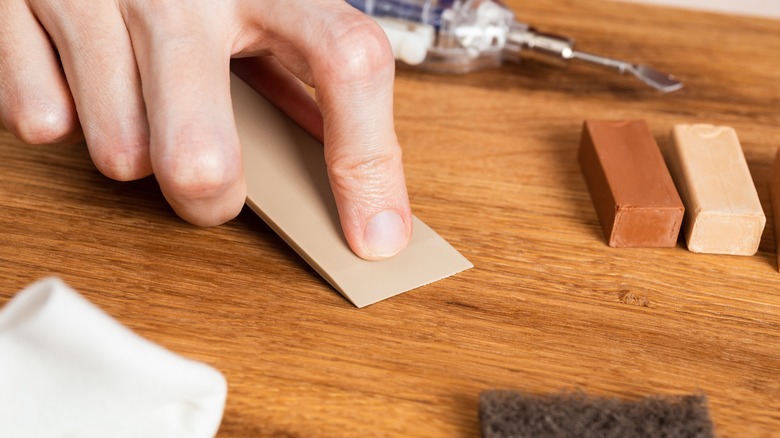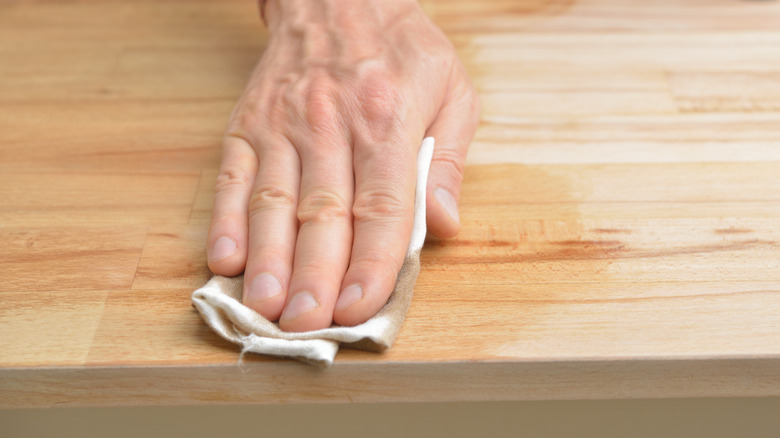A Clever Way To Give An Old Butcher Block Countertop New Life
No matter what type of design you're going for in your home — farmhouse, country cottage, or boho chic — having a butcher block countertop in your kitchen can compliment the vibe. This kind of surface can be formed by gluing multiple pieces of the same wood together or various types of different woods in order to create a unique pattern. Traditionally made from hardwoods such as cherry, oak, walnut, or maple, a sturdy well-made butcher block countertop can last several decades.
According to Forbes, these countertops can be designed to showcase the face grain, which is the wider surface of the wood, the edge grain for long narrow strips of material, or the end grain, which creates a checkerboard pattern. These countertops are not as affordable as laminate veneers, yet they don't have the hefty price tag of a stone or marble counter. Because you have the ability to cut your fruits and veggies right on the surface, as the namesake implies, you'll eventually find that the exterior layer has been be affected by nicks, cuts, scrapes, stains, and burns. Before the damage gets too dire, it's important to take the necessary steps to treat your countertop in order to make it last longer and stay looking its best. Let's check out how you can bring new life to your old butcher block countertop.
Disinfect your countertop
The first step towards revitalizing your old butcher block surface is to clean and disinfect it. Remove countertop appliances, dish racks, storage jars, or anything else you keep on the counter. Then give the entire thing a quick dry wipe down to remove crumbs and caked on food.
For this deep clean, don't reach for the bleach; harsh chemical cleansers can damage the wood and potentially cause more of a mess than what you started out with. Instead, mix up a natural cleaning solution by using equal parts water and distilled white vinegar, which can be a versatile cleaning tool. According to WebMD, this solution works best when heated. Add a few drops of lemon juice and pour it all into a spray bottle, then lightly spritz the countertop and let it sit for a few moments. The acidic properties in the vinegar and lemon will help to kill any bacteria that may be lurking about. The lemon will also provide a refreshing scent. The countertops should then be adequately prepared for you to move on with the rest of the project.
Rid the surface of stains
Your wooden countertop is bound to get stains on the surface after multiple years of use. Because wood is a porous substance and able to absorb liquids, you might find yourself with unsightly messes to deal with. From water rings to red wine and fruit juice spills, these stains can settle in and make an eyesore out of your counter, however, that's no reason to worry. Luckily, it can be simple to remove stains from your butcher block countertop.
For this task it is best, once again, to use natural ingredients on the wood surface. As already mentioned, harsh chemicals such as bleach could result in additional stains to your counter. To effectively tackle any seeped in stains use a helpful combination of salt and lemon juice mixed together to form a paste. This mixture blends the stain-lifting acidic power of lemon juice and the scouring properties of salt, which can then be rubbed into the areas. According to HGTV, this will ideally lift the mess right out of the wood. Salt and lemon juice can work wonders on greasy marks or even deep-set spills. Once you have successfully removed all of the messes from the countertop, you can wipe it down once more with a clean rag.
Sand out the cuts and burn marks
Now that your countertop is bacteria-free and all stains have been obliterated, you can tend to cuts or burn marks that may have occurred over time. Overzealous knife work and hot pots or pans placed on butcher block can all result in gouges or deep burn marks visible on the surface. One sure way to eliminate these blemishes is to sand your whole countertop. Sanding will take off a thin layer from the exterior and help to smooth out the finish.
To get the job done you can use either a sanding block or a handheld orbital sander. Both can be incredibly effective in smoothing the surface, and with either method, you should use 180 grit paper, recommends The Grit and Polish. Apply light pressure with even strokes as you move over the countertop. If you press too hard as you sand, you might go deeper into the surface than you'd like, and this could create a visually unappealing uneven and wavy texture to your counter. Once the job is finished, run your hand across the surface to ensure that you have the texture smoothed just the way you like it. If it feels as though it needs more work then you can continue to sand, otherwise, if you're happy with the results you can clean up the dust and debris with a vacuum cleaner and get ready for the next step.
Fill in any cracks
After sanding your wooden countertop you might find that there are some deeper cracks that can't be fixed by further sanding. In that case, you'll need to fill them in. Cracks can sometimes form in butcher block countertops because of the changing temperature in the air. For instance, a drop in humidity will force the wood to shrink. This can be especially problematic in areas that experience drastic seasonal changes. For an optimal wood-friendly indoor atmosphere, try to keep the air in your home at a level of 50% relative humidity so that your surface won't dry out, suggests J. Aaron Custom Wood Countertops.
It can be rather simple to fix minor cracks in your countertops. Simply melt some furniture or canning wax in a small pan over low heat. Once the wax is melted, carefully pour the liquid into the cracks you want to fill. Allow the wax to fully dry, then use a plastic scraper to gently remove the excess. Finally, smooth out the surface with a cloth. Ideally, this wax filler will expand and contract with the wood during periods of fluctuating temperatures and humidity. That will keep the wood from drying out and experiencing more issues.
Add a protective seal
Once the surface is completely smooth and clear of cracks, it's time to treat it with a sealant. This helps to protect the wood and keep it conditioned so it won't easily dry out again. Although there are plenty of products out there that offer complete wood protection for your countertops, it helps to read the ingredients to keep from purchasing something that may be harmful.
Polyurethane, urethane, and epoxy sealants, for instance, offer an almost plastic-like finish to your wood, however, this can break down over time and could contain chemicals that would be hazardous to your health, warns Green Home Guide. Instead, there are natural products you can use that offer the same type of wood protection without the worry of harming anyone in your household. Products that contain beeswax and mineral oils are able to condition your butcher block countertops, adding durability to the exterior while replenishing the moisture that lies under the surface.
Simply use a clean cloth to rub the product onto the surface of your counter. Repeat this process several times to ensure that the sealant is penetrating the wood. At this point, your old butcher block countertop should look like it has been completely renewed. With a smooth top and a revitalized finish, it is sure to stand out once again. To keep it looking its best, you can continue to re-apply your wood conditioner to ensure its quality.
